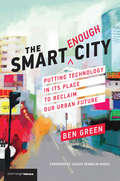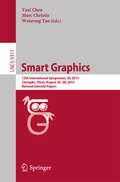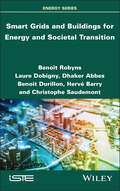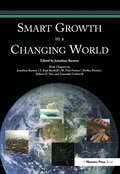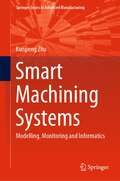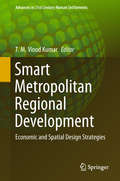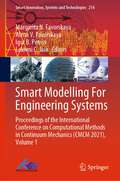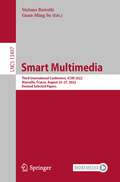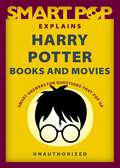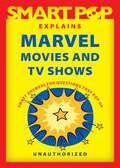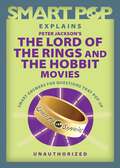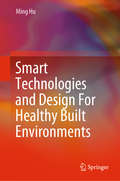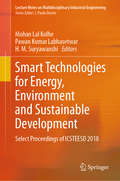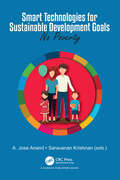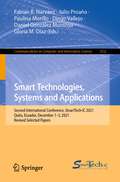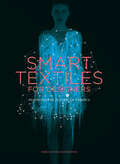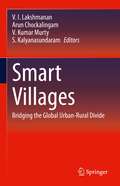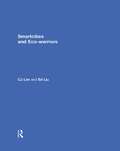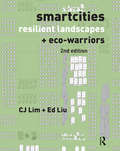- Table View
- List View
The Smart Enough City: Putting Technology in Its Place to Reclaim Our Urban Future (Strong Ideas)
by Ben GreenWhy technology is not an end in itself, and how cities can be “smart enough,” using technology to promote democracy and equity.Smart cities, where technology is used to solve every problem, are hailed as futuristic urban utopias. We are promised that apps, algorithms, and artificial intelligence will relieve congestion, restore democracy, prevent crime, and improve public services. In The Smart Enough City, Ben Green warns against seeing the city only through the lens of technology; taking an exclusively technical view of urban life will lead to cities that appear smart but under the surface are rife with injustice and inequality. He proposes instead that cities strive to be “smart enough”: to embrace technology as a powerful tool when used in conjunction with other forms of social change—but not to value technology as an end in itself.In a technology-centric smart city, self-driving cars have the run of downtown and force out pedestrians, civic engagement is limited to requesting services through an app, police use algorithms to justify and perpetuate racist practices, and governments and private companies surveil public space to control behavior. Green describes smart city efforts gone wrong but also smart enough alternatives, attainable with the help of technology but not reducible to technology: a livable city, a democratic city, a just city, a responsible city, and an innovative city. By recognizing the complexity of urban life rather than merely seeing the city as something to optimize, these Smart Enough Cities successfully incorporate technology into a holistic vision of justice and equity.
Smart Graphics
by Yaxi Chen Marc Christie Wenrong TanFor centuries, artists and designers have been creating communicative graphics. With the advent of new forms of media, the emergence of paradigms such as ubiquitous computing, and the rapid evolution of interaction devices, there is a continuous cycle of renewal of the technologies and methods to support artists, interaction designers and developers. Developingnewapproachesrequiresanunderstandingofthe fundamentals of perception and cognition as they relate to interaction and communication te- nologies, together with arti?cial intelligence and computer graphics techniques to automate reasoning and enhance cognition. Smart Graphics is in essence an interdisciplinary endeavor and brings together the ?elds of computer graphics, arti?cial intelligence, cognitive science, graphic design and ?ne art. The International Symposium on Smart Graphics 2008 was held on August 27-29 in Rennes, France. It was the ninth event in a series which originally started in 2000 as an American Association for Arti?cial Intelligence Spring Symposium and has taken place every year since then. Due to the high quality of the papers submitted this year, the ProgramCommittee decided to accept 17 fullpapers(insteadoftheusual15),9shortpapersand3systemdemonstrations. The acceptance rate for full papers was 34%. This year's meeting included a discussion as to the nature of the shape, contentandfutureoftheevent. Representativesfromdi?erentcommunitieswere invitedtogivetheiropinions,andtheorganizingcommitteewouldliketowarmly thank them here. Such questions as the ongoing viability of the symposium and theconsequencesofco-locatingSmartGraphicswithotherlargerresearchevents led to interesting debates and have prepared the groundwork for what could be the future of the Smart Graphics conference series.
Smart Graphics: 13th International Symposium, SG 2015, Chengdu, China, August 26-28, 2015, Revised Selected Papers (Lecture Notes in Computer Science #9317)
by Yaxi Chen, Marc Christie and Wenrong TanThis book constitutes the proceedings of the 13th International Symposium on Smart Graphics, SG 2015, held in Chengdu, China, in August 2015. The 17 full and 3 short papers presented in this volume were carefully reviewed and selected from 35 submissions. They are organized in topical sections named: graphics, sketching and visualization, automation and evaluation, image processing, and posters and demo session.
Smart Grids and Buildings for Energy and Societal Transition
by Benoît Robyns Christophe Saudemont Hervé Barry Dhaker Abbes Laure Dobigny Benoit DurillonThis book presents interdisciplinary approaches to help buildings, electrical energy networks and their users contribute to the energy and societal transition. Smart Grids and Buildings for Energy and Societal Transition examines the technologies, uses and imaginaries involved in implementing smart buildings and smart grids. Production and consumption forecasts, modeling of stakeholder involvement and self-consumption within a renewable energy community exploiting blockchain technology are examples developed with a view to fostering the emergence of smart grids. The potential of smart buildings, taking into account user comfort while increasing energy efficiency, is identified. Full-scale demonstrators are used to test the proposed solutions, and to ensure that users take full advantage of the potential for electrical flexibility.
Smart Growth in a Changing World
by Jonathan BarnettThis book is the latest book from the author, documents the United States' hidden crisis and shows how balanced transportation and natural resources preservation can make new urban development sustainable, as well as more efficient and more equitable.
Smart Machining Systems: Modelling, Monitoring and Informatics (Springer Series in Advanced Manufacturing)
by Kunpeng ZhuThis book provides the tools to enhance the precision, automation and intelligence of modern CNC machining systems. Based on a detailed description of the technical foundations of the machining monitoring system, it develops the general idea of design and implementation of smart machining monitoring systems, focusing on the tool condition monitoring system. The book is structured in two parts. Part I discusses the fundamentals of machining systems, including modeling of machining processes, mathematical basics of condition monitoring and the framework of TCM from a machine learning perspective. Part II is then focused on the applications of these theories. It explains sensory signal processing and feature extraction, as well as the cyber-physical system of the smart machining system. Its utilisation of numerous illustrations and diagrams explain the ideas presented in a clear way, making this book a valuable reference for researchers, graduate students and engineers alike.
Smart Materials and Technologies in Architecture: For The Architecture And Design Professions
by Daniel Schodek Michelle AddingtonToday, architects and designers are beginning to look toward developments in new"smart" or "intelligent" materials and technologies for solutions to long-standing problemsin building design. However, these new materials have so far been applied in a diversebut largely idiosyncratic nature, because relatively few architects have access toinformation about the types or properties of these new materials or technologies.Two of the leading experts in this field - Addington and Schodek - have solved thisproblem by incorporating all the relevant information of all the latest technologiesavailable to architects and designers in this one volume. They present materials bydescribing their fundamental characteristics, and go on to identify and suggest howthese same characteristics can be exploited by professionals to achieve their designgoals. Here, the wealth of technical understanding already available in the materialsscience and engineering literature is at last made accessible to a design audience.
Smart Metropolitan Regional Development: Economic And Spatial Design Strategies (Advances in 21st Century Human Settlements)
by T.M. Vinod KumarThis book discusses the concept and practice of a smart metropolitan region, and how smart cities promote healthy economic and spatial development. It highlights how smart metropolitan regional development can energize, reorganize and transform the legacy economy into a smart economy; how it can help embrace Information and Communications Technology (ICT); and how it can foster a shared economy. In addition, it outlines how the five pillars of the third industrial revolution can be achieved by smart communities. In addition, the book draws on 16 in-depth city case studies from ten countries to explore the state of the art regarding the smart economy in smart cities – and to apply the lessons learned to shape smart metropolitan economic and spatial development.
Smart Modelling for Engineering Systems: Proceedings of the International Conference on Computational Methods in Continuum Mechanics (CMCM 2021), Volume 2 (Smart Innovation, Systems and Technologies #215)
by Margarita N. Favorskaya Alena V. Favorskaya Igor B. Petrov Lakhmi C. JainThis book is a collection of research papers selected for presentation at the International Conference on Smart Computational Methods in Continuum Mechanics 2021, organized by Moscow Institute of Physics and Technology and the Institute for Computer Aided Design of Russian Academy of Sciences. The work is presented in two volumes. The primary objective of the book is to report the state-of-the-art on smart computational paradigms in continuum mechanics and explore the use of artificial intelligence paradigms such as neural nets and machine learning for improving the performance of the designed engineering systems. The book includes up-to-date smart computational methods which are used to solve problems in continuum mechanics, engineering, seismic prospecting, non-destructive testing, and so on. The main features of the book are the research papers on the application of novel smart methods including neural nets and machine learning, computational algorithms, smart software systems, and high-performance computer systems for solving complex engineering problems. The case studies pertaining to the real-world applications in the above fields are included. The book presents a collection of best research papers in English language from some of the world leaders in the field of smart system modelling and design of engineering systems.
Smart Modelling For Engineering Systems: Proceedings of the International Conference on Computational Methods in Continuum Mechanics (CMCM 2021), Volume 1 (Smart Innovation, Systems and Technologies #214)
by Lakhmi C. Jain Margarita N. Favorskaya Alena V. Favorskaya Igor B. PetrovThis book is a collection of research papers selected for presentation at the International Conference on Smart Computational Methods in Continuum Mechanics 2021, organized by Moscow Institute of Physics and Technology and the Institute for Computer Aided Design of Russian Academy of Sciences. The work is presented in two volumes. The primary objective of the book is to report the state-of-the-art on smart computational paradigms in continuum mechanics and explore the use of artificial intelligence paradigms such as neural nets, and machine learning for improving the performance of the designed engineering systems. The book includes up-to-date smart computational methods which are used to solve problems in continuum mechanics, engineering, seismic prospecting, non-destructive testing, and so on. The main features of the book are the research papers on the application of novel smart methods including neural nets and machine learning, computational algorithms, smart software systems, and high-performance computer systems for solving complex engineering problems. The case studies pertaining to the real-world applications in the above fields are included. The book presents a collection of best research papers in English language from some of the world leaders in the field of smart system modelling and design of engineering systems.
Smart Multimedia: Third International Conference, ICSM 2022, Marseille, France, August 25–27, 2022, Revised Selected Papers (Lecture Notes in Computer Science #13497)
by Guan-Ming Su Stefano BerrettiThis book constitutes the proceedings of the Third International Conference on Smart Multimedia, ICSM 2022, which was held in Marseille, France, during August 25–27, 2022.The 30 full papers and 4 short paper presented in this volume were carefully reviewed and selected from 68 submissions. The contributions were organized in topical sections as follows: Machine Learning for Multimedia; Image Processing; Multimedia Applications; Multimedia for Medicine and Health-Care; Smart Homes; Multimedia Environments and Metaverse; Deep Learning on Video and Music; Haptic; Industrial.
Smart Pop Explains Harry Potter Books and Movies
by The Editors of Smart PopWho is Snape? What&’s a horcrux? When did Sirius Black escape from Azkaban? Why was Hermione sorted into Gryffindor? It&’s easy for new fans to get overwhelmed by the sprawling mythology and complexity of the Harry Potter movies and books. Unlike encyclopedias and guides that offer diehard fans trivia, details, and deep dives into every on-screen moment, this first-of-its-kind explainer is an easy, fun, and accessible introduction to the hundreds of characters, plots, and interconnected stories that make up one of the greatest pop culture franchises of all time. Maybe you&’re a First Year and need an entry level class on the magical Hogwarts School of Witchcraft and Wizardry? Are you trying to figure out why Slytherins are so slippery? Trying to parcel out parceltongue? Having trouble sorting out when Dumbledore battled Grindelwald? Or maybe you&’re a confident Ravenclaw who wants to understand why it&’s leviOsa, not levioSA! If you&’re a Muggle, witch, or wizard looking for an easy entry into what literally everyone is talking about then this is the book for you. As the perfect and unauthorized resource to keep on hand when watching something for the first—or tenth—time, Smart Pop ExplainsHarry Potter Movies and Books to you like no one could!
Smart Pop Explains Marvel Movies and TV Shows
by The Editors of Smart PopWho is Iron Man? What&’s an Infinity Stone? When did Captain America become the first Avenger? Why does everyone love Loki even though he&’s a bad guy? It&’s easy for new fans to get overwhelmed by the sprawling mythology and complexity of the Marvel Cinematic Universe, which now spans more than 20 films and TV shows. Unlike encyclopedias and guides that offer diehard fans trivia, details, and deep dives into every on-screen moment, this first-of-its-kind explainer is an easy, fun, and accessible introduction to the hundreds of characters, plots, and interconnected stories that make up one of the greatest pop-culture franchises of all time. Do you want to enjoy Spider-Man, but don&’t quite know what a Skrull is? Maybe you know that it was Agatha all along, but did maybe WandaVision leave you wondering about the multiverse of madness? Do you need a primer on Thor&’s backstory so you can grasp how The God of Thunder became friends with The Guardians of the Galaxy? Or, maybe you just want to be able to join in when everyone shouts out &“Wakanda Forever!&” If you&’re looking for an easy to access entry into what literally everyone is talking about, this is the book for you! As the perfect and unauthorized resource to keep on hand when watching something for the first—or tenth—time, Smart Pop Explains Marvel Movies and TV Shows like no one else could.
Smart Pop Explains Peter Jackson's The Lord of the Rings and The Hobbit Movies
by Peter Jackson’sReturn to Middle-earth ahead of Amazon Prime's new series The Lord of the Rings: The Rings of Power If you&’re feeling lost on the way to Mordor, let Smart Pop be your guide—literally, with this handy crash course into the cinematic world of Hobbits and Orcs and Elves (oh my!) It&’s easy for new fans to get overwhelmed by the sprawling mythology and complexity of the six films that make up Peter Jackson&’s epic trilogies. Unlike encyclopedias and guides that offer diehard J.R.R. Tolkien fans trivia, details, and deep dives into every on-screen moment, this first-of-its kind explainer is an easy, fun, and accessible introduction to the characters, plots, and interconnected stories that make up one of the greatest pop culture franchises of all time. Smart Pop has all of your burning questions covered: Who is Frodo? Why are there so many rings? When did Gandalf the Grey have time to change outfits and become Gandalf the White? Why does everyone love Gollum even though he&’s a bad guy? And more! As the perfect and unauthorized resource to keep on hand when rewatching the films for the first—or tenth time, or as a primer for the upcoming live action series, Smart Pop Explains Peter Jackson&’s The Lord of the Rings and The Hobbit Movies to you like no one could!
Smart Technologies and Design For Healthy Built Environments (Springerbriefs In Applied Sciences And Technology Ser.)
by Ming HuSmart Technologies and Design for Healthy Built Environment connects smart technology to a healthy built environmentthat builds upon the sustainable building movement.It provides an overall summary of the state-of-the-art technologies that are applied in the built environment. The book covers a broad spectrum of smart technology categories ranging from dynamic operability, energy efficiency, self-regulating and self-learning systems, and responsive systems. The foreseeable challenges that are associated with smart technologies are discussed and outlined in the book. Firstly, this book provides a snapshot of state-of-the-art smart technologies being applied in the built environment. It covers a broad spectrum of smart technology categories, ranging from dynamic operability, energy efficiency, self-regulating and self-learning systems, to responsive systems. Secondly, this book provides in-depth analysis of the four primary components of health (biological, physical, physiological and psychological); their effects on wellbeing and cognitive performance are introduced as well. Thirdly, it connects smart technologies to those health-influencing factors by reviewing three completed smart building projects. This book can also serve as a basis for education and discussion among professionals and students of diverse backgrounds who are interested in smart technologies, smart building, and healthy building. Smart Technologies and Design for Healthy Built Environment serves as the basis for education and discussions among professionals and students who are interested in smart technologies, smart building and healthy building, as it bridges the gap between smart technologies and a healthy built environment. The book also provides a foundation for anyone who is interested in the impact of smart technology on the health of built environment.
Smart Technologies for Energy, Environment and Sustainable Development: Select Proceedings of ICSTEESD 2018 (Lecture Notes on Multidisciplinary Industrial Engineering)
by Mohan Lal Kolhe Pawan Kumar Labhasetwar H. M. SuryawanshiThis book comprises select proceedings of the International Conference on Smart Technologies for Energy, Environment, and Sustainable Development (ICSTEESD 2018). The chapters are broadly divided into three focus areas, viz. energy, environment, and sustainable development, and discusses the relevance and applications of smart technologies in these fields. A wide variety of topics such as renewable energy, energy conservation and management, energy policy and planning, environmental management, marine environment, green building, smart cities, smart transportation are covered in this book. Researchers and professionals from varied engineering backgrounds contribute chapters with an aim to provide economically viable solutions to sustainable development challenges. The book will prove useful for academics, professionals, and policy makers interested in sustainable development.
Smart Technologies for Sustainable Development: Select Proceedings of SMTS 2019 (Lecture Notes in Civil Engineering #78)
by Sanjay Kumar Shukla Srinivasan Chandrasekaran Bibhuti Bhusan Das Sreevalsa KolathayarThis book presents select papers from the International Conference on Smart Materials and Techniques for Sustainable Development (SMTS) 2019. The contents focus on a wide range of methods and techniques related to sustainable development fields like smart structures and materials, innovation in water resource development, optical fiber communication, green construction materials, optimization and innovation in structural design, structural dynamics and earthquake engineering, structural health monitoring, nanomaterials, nanotechnology and sensors, smart biomaterials and medical devices, materials for energy conversion and storage devices, and IoT in sustainable development. This book aims to provide up-to-date and authoritative knowledge from both industrial and academic worlds, sharing best practice in the field of smart materials analysis. The contents of this book will be beneficial to students, researchers, and professionals working in the field of smart materials and sustainable development.
Smart Technologies for Sustainable Development Goals: No Poverty
by A. Jose Anand Saravanan KrishnanSustainable Development Goals or SDGs refer to the UN stipulated road-map for development in 17 defined areas, by 2030. It was built on the previously established Millennium Development Goals (MDG). This first volume (SDG-1) deals with eradicating poverty with the help of modern ICT technologies needed to end poverty and create a better society. This much needed book, which is the first of its type to offer a specific focus on the relationship between technology and the SDG-1 goal, will be valuable for all working in the subject of global sustainable development. Global organisations and representatives of governments targeting no poverty share knowledge on these ICT practices to eradicate poverty in all means.
Smart Technologies, Systems and Applications: Second International Conference, SmartTech-IC 2021, Quito, Ecuador, December 1–3, 2021, Revised Selected Papers (Communications in Computer and Information Science #1532)
by Fabián R. Narváez Julio Proaño Paulina Morillo Diego Vallejo Daniel González Montoya Gloria M. DíazThis book constitutes refereed proceedings of the Second International Conference on Smart Technologies, Systems and Applications, held in Quito, Ecuador, in December 2021. Due to the COVID-19 pandemic the conference was held in a hybrid format. The 29 full papers along with 1 short paper presented were carefully reviewed and selected from 104 submissions. The papers of this volume are organized in topical sections on smart technologies; smart systems; smart trends and applications.
Smart Textiles
by Stefan Schneegass Oliver AmftFrom a holistic perspective, this handbook explores the design, development and production of smart textiles and textile electronics, breaking with the traditional silo-structure of smart textile research and development. Leading experts from different domains including textile production, electrical engineering, interaction design and human-computer interaction (HCI) address production processes in their entirety by exploring important concepts and topics like textile manufacturing, sensor and actuator development for textiles, the integration of electronics into textiles and the interaction with textiles. In addition, different application scenarios, where smart textiles play a key role, are presented too. Smart Textiles would be an ideal resource for researchers, designers and academics who are interested in understanding the overall process in creating viable smart textiles.
Smart Textiles for Designers: Inventing The Future Of Fabrics
by Rebeccah Pailes-FriedmanWe are on the cusp of a revolution, where the intersection of technology, the human body and everyday objects will become completely seamless. Smart textiles are a key part of this revolution.Smart Textiles for Designers introduces the different qualities and properties that can be embedded in, integrated with, and applied to fabrics and looks at the different contexts in which these smart textiles can be used, from healthcare to haute couture, firefighting to sportswear. A survey of specific fabrics grouped by properties provides a core reference section and a palette for the designer to work from. The book also examines five different design approaches and features interviews with leading designers and design teams, showing their processes and working methods.The first book to look at this exciting and quickly developing area of technology through the eyes of a designer, this is both a core reference work and an inspirational guide for students and professionals alike.
Smart Textiles for Designers: Inventing the Future of Fabric
by Rebeccah Pailes-FriedmanWe are on the cusp of a revolution, where the intersection of technology, the human body and everyday objects will become completely seamless. Smart textiles are a key part of this revolution.Smart Textiles for Designers introduces the different qualities and properties that can be embedded in, integrated with, and applied to fabrics and looks at the different contexts in which these smart textiles can be used, from healthcare to haute couture, firefighting to sportswear. A survey of specific fabrics grouped by properties provides a core reference section and a palette for the designer to work from. The book also examines five different design approaches and features interviews with leading designers and design teams, showing their processes and working methods.The first book to look at this exciting and quickly developing area of technology through the eyes of a designer, this is both a core reference work and an inspirational guide for students and professionals alike.
Smart Villages: Bridging the Global Urban-Rural Divide
by V. I. Lakshmanan Arun Chockalingam V. Kumar Murty S. KalyanasundaramThis book brings together technical expertise, best practices, case studies and ground-level application of the ideas for empowering the rural population of the world to live economically prosperous, environmentally sustainable, and socially progressive lives, on par or comparable with the quality of life enjoyed by the global urban population. The idea of Smart Villages takes on greater urgency in light of the investments made in this millennium on “Smart Cities”, taking advantage of the technological advances, particularly in digital connectivity. These investments have and will continue to expand the urban-rural divide, unless similar investments are made in the villages as well. The book provides a much-needed guide for a holistic development of a Smart Village, by defining the need, developing the framework, and describing the delivery, complete with successful case studies. Contributors to the book, from Canada, USA, Africa and India bring years of academic, industry and governmental experience, including organization of several Smart Village conferences. The knowledge base in the book will be of great value to anyone interested in or active in rural planning, including governmental and non-governmental organizations, industrial solution providers, public healthcare professionals, public policy professionals and students, as well as rural communities around the world. Consolidates all the aspects of creating/developing a Smart Village;Delivers an effective tool-kit for practitioners in the area of Smart Villages;Provides a policy-based framework for the development of an ideal Smart Village;Illustrates, through case studies, the fulfillment of key requirements of a Smart Village;Brings together experts from around the world to share their vision of a Smart Village;Highlights the importance of balancing development with social/gender equity and cultural traditions.
Smartcities and Eco-Warriors: The Ecological Landscapes For Urban Resilience
by Cj Lim Ed LiuModern methods of agriculture have led to cities growing out of control and reducing the available agricultural land, threatening the sustainability of our food system. The previous mutually sustaining relationships of animals, humans and the land have been lost with the progress of industry. The Smartcity – an ecological symbiosis between nature, society and the built form – is the innovative response to contemporary problems from one of the world’s leading urban design and architectural thinkers. Addressing the problems of unchecked city growth, the idea of the Smartcity questions whether we could begin to live once again from first principles, focusing in on the inhabitants of the city. The holistic construct of the Smartcity is developed through a series of international case studies, some commissioned by government organisations, others speculative and polemic. Reframing the way people think about urban green space and the evolution of cities, CJ Lim and Ed Liu explore how the reintegration of agriculture in urban environments can cultivate new spatial practices and social cohesion in addition to food for our tables. Representing an emerging architectural voice in matters of environmental and social sustainability, Smartcities and Eco-warriors is a long overdue treatment of the subject from a designer’s perspective, and is essential reading for practitioners and students in the fields of architecture, urban planning, environmental engineering, landscape design, agriculture and sociology. An inspiration to government agencies and NGOs dealing with climate change, it also resonates with anyone concerned about cities, energy conservation and the future of food
Smartcities, Resilient Landscapes and Eco-Warriors: Resilient Landscapes + Eco-warriors
by CJ Lim Ed LiuFollowing on from the success of the first edition, Smartcities + Eco-Warriors (2010), this book is the latest innovative response on urban resilience from one of the world’s leading urban design and architectural thinkers. An ecological symbiosis between nature, society and the built form, the Smartcity cultivates new spatial practices and creates diverse forms of resilient landscapes including and beyond urban agriculture. The notion of the Smartcity is developed through a series of international case studies, some commissioned by government organisations, others speculative and polemic. This second edition has nine new case studies, and additional ecological sustainability studies covering sensitivity, design criteria, and assessments for ecological construction plans. The book concludes with two new essays on the romance of trees and the empowering nature of resilient landscapes. Smartcities, Resilient Landscapes + Eco-warriors represents a crucial voice in the discourse of climate change and the potential opportunities to improve the ecological function of existing habitats or create new landscapes which are considered beneficial to local ecology and resilience. It is indispensable reading for practitioners and students in the fields of landscape, urban design, architecture and environmental engineering. An inspiration to government agencies and NGOs dealing with sustainability, this work also resonates with anyone concerned about cities, landscapes, food and water security, and energy conservation.
